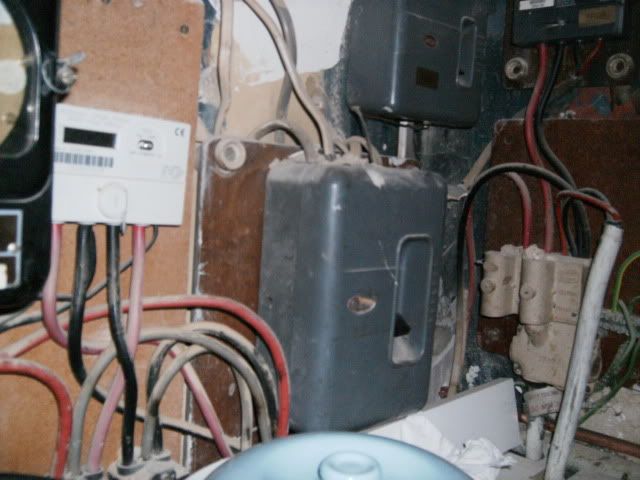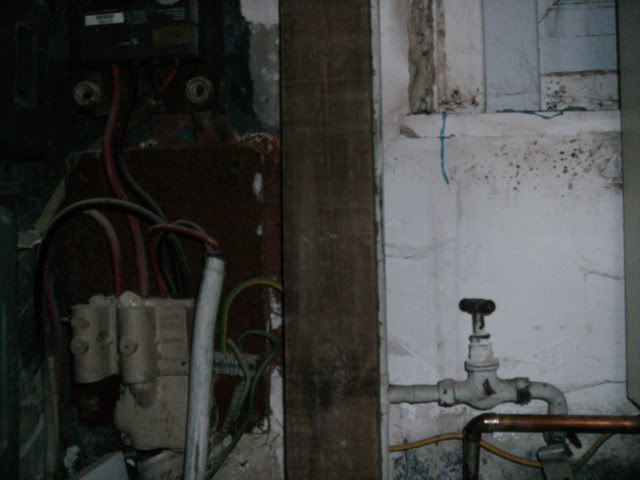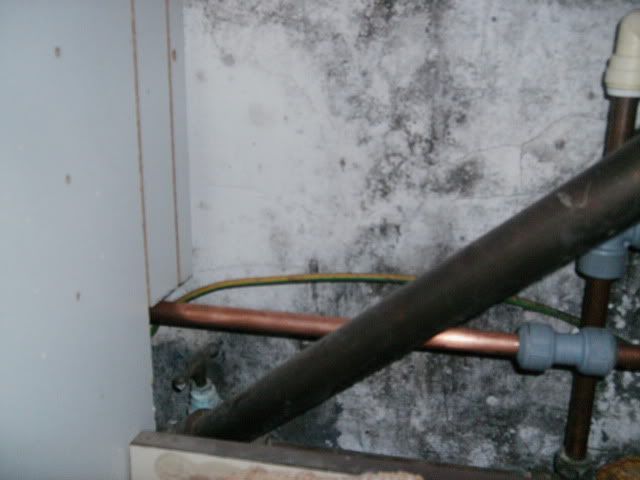Hi everyone. i'm wondering how much it would generally cost for a sparky to blank a couple of double sockets in an old bedroom im turning into a bathroom? assuming that thats all that needs to be done. i think they should still need to be accessable as the floor is being boarded and tiled. thanks in advance.
You are using an out of date browser. It may not display this or other websites correctly.
You should upgrade or use an alternative browser.
You should upgrade or use an alternative browser.
blanking sockets in a bathroom, how much?
- Thread starter slothrop23
- Start date
Sponsored Links
- Joined
- 27 Jan 2008
- Messages
- 23,679
- Reaction score
- 2,668
- Location
- Llanfair Caereinion, Nr Welshpool
- Country

He is likely going to have to remove all wiring and it is impossible to cost a job of that type without being there and seeing all that will be involved.
First up let me say that I ain't a sparkie by trade but I have done city a guilds in various electrical qualifications. The opinion I am expressing is my opinion and may be incorrect.
This is an interesting one. Under schedule P you are allowed to carry out minor works which include extending or modifying an existing ring main or lighting cirtuit, providing you don't alter the wiring to the consumer unit in any way and providing that the alterations are not in a bathroom or kitchen. Now what you are proposing is to remove some sockets from a room that is not yet a bathroom. Surely you could remove the sockets, pull the cables back to the void space in the ceiling or floor and joint the cables with a suitable junction box. You would then be free to plaster over the old socket holes. This room is not yet a bathroom so one would think you weren't breaking the regs to do that but don't quote me. A sparkie may contradict me on this, but that is what I understand from schedule P.
The most important thing is that you don't leave unused ring main cable in places it doesn't relate to a socket. Future occupants of the home have no way of knowing that the redundant live cable is there and this could cause serious accidents if they decided to put nails or screws into the walls.
This is an interesting one. Under schedule P you are allowed to carry out minor works which include extending or modifying an existing ring main or lighting cirtuit, providing you don't alter the wiring to the consumer unit in any way and providing that the alterations are not in a bathroom or kitchen. Now what you are proposing is to remove some sockets from a room that is not yet a bathroom. Surely you could remove the sockets, pull the cables back to the void space in the ceiling or floor and joint the cables with a suitable junction box. You would then be free to plaster over the old socket holes. This room is not yet a bathroom so one would think you weren't breaking the regs to do that but don't quote me. A sparkie may contradict me on this, but that is what I understand from schedule P.
The most important thing is that you don't leave unused ring main cable in places it doesn't relate to a socket. Future occupants of the home have no way of knowing that the redundant live cable is there and this could cause serious accidents if they decided to put nails or screws into the walls.
Everything that dented has said is true except for
You would pull the cable out of the wall into the void but you must not put a junction box there unless you can access it.
If its under the (soon to be) tiled bathroom floor then the cable connection must be permanent. options are:
proper crimped connections done with a proper crimp tool with the joint covered with shrink sleeving
or
soldered connection with the joint covered with shrink sleeving
or
Remove the section of cable by running new piece between the previous and next socket.
Surely you could remove the sockets, pull the cables back to the void space in the ceiling or floor and joint the cables with a suitable junction box
You would pull the cable out of the wall into the void but you must not put a junction box there unless you can access it.
If its under the (soon to be) tiled bathroom floor then the cable connection must be permanent. options are:
proper crimped connections done with a proper crimp tool with the joint covered with shrink sleeving
or
soldered connection with the joint covered with shrink sleeving
or
Remove the section of cable by running new piece between the previous and next socket.
Sponsored Links
It's Part P.Now what you are proposing is to remove some sockets from a room that is not yet a bathroom. Surely you could remove the sockets, pull the cables back to the void space in the ceiling or floor and joint the cables with a suitable junction box. You would then be free to plaster over the old socket holes. This room is not yet a bathroom so one would think you weren't breaking the regs to do that but don't quote me. A sparkie may contradict me on this, but that is what I understand from schedule P.
Part P (in fact all of the Building Regulations) applies to any work whatsoever on fixed electrical cables or fixed electrical equipment located on the consumer’s side of the electricity supply meter which operate at low or extra-low voltage and are—
(a) in or attached to a dwelling;
(b) in the common parts of a building serving one or more dwellings, but excluding power supplies to lifts;
(c) in a building that receives its electricity from a source located within or shared with a dwelling; or
(d) in a garden or in or on land associated with a building where the electricity is from a source located within or shared with a dwelling.
Some work is notifiable, some is not. That which is not is listed in Schedule 2B.
Removing sockets is not in Schedule 2B, therefore the work proposed is notifiable, no matter which room it is in.
- Joined
- 27 Jan 2008
- Messages
- 23,679
- Reaction score
- 2,668
- Location
- Llanfair Caereinion, Nr Welshpool
- Country

It is a lot of wading through to find Page 38 and it seems to be in rather general terms but I can see it says you can fit a socket but no where does it include the removal of anything.
I suppose since they are "Building Regulations" and not "Dismantle Regulations" it wouldn't as when you remove items your not "Building".
However non of what has been said answers the man's question. I am sure if building work is going on then the LABC will be involved and all this what he can and can't do without notice under Part P is really nothing to do with the question.
Quite plain he does not intend to DIY he only asks for cost. I would guess it would take less than half a day so looking at around 4 hours as very little takes less so top of head I would expect a bill of under £100.
OK I have given a figure now forget Part P and say if I have under or over estimated in your opinion and answer the guys question instead of inventing your own!
P.S. can the be turned to face the room other side of the wall? That may be an easier option.
I suppose since they are "Building Regulations" and not "Dismantle Regulations" it wouldn't as when you remove items your not "Building".
However non of what has been said answers the man's question. I am sure if building work is going on then the LABC will be involved and all this what he can and can't do without notice under Part P is really nothing to do with the question.
how much it would generally cost for a sparky to blank a couple of double sockets
Quite plain he does not intend to DIY he only asks for cost. I would guess it would take less than half a day so looking at around 4 hours as very little takes less so top of head I would expect a bill of under £100.
OK I have given a figure now forget Part P and say if I have under or over estimated in your opinion and answer the guys question instead of inventing your own!
P.S. can the be turned to face the room other side of the wall? That may be an easier option.
moving a bathroom would require LABC to be involved anyway since it involves ventilation, moving waste connections etc..
thankyou ericmark. i'm sure the electrician will know what needs to be done. but also thanks for all the other bits of info, its an interesting project and i'm totally out of my depth with electrics and plumbing, when you plaster wrong you don't twitch involuntarily for years afterwards!
actually the bedroom used to be the bathroom and was changed without notice so we are really just restoring it to its original state albeit updated. its weird that i can't find any general searches on the laws for removing sockets. Also the main electrics board is not there, its just a black box with ours and upstairs meter under our sink! no consumer unit no fuses, nothing. why didn't the survey or insurers notify us that this would need to be looked at? any suggestions?
actually the bedroom used to be the bathroom and was changed without notice so we are really just restoring it to its original state albeit updated. its weird that i can't find any general searches on the laws for removing sockets. Also the main electrics board is not there, its just a black box with ours and upstairs meter under our sink! no consumer unit no fuses, nothing. why didn't the survey or insurers notify us that this would need to be looked at? any suggestions?
ericmark, unfortunately the kitchen is on the otherside of the wall. and as i may have said the plug would come out by the "electric unit"
“building work” has the meaning given in regulation 3(1);It is a lot of wading through to find Page 38 and it seems to be in rather general terms but I can see it says you can fit a socket but no where does it include the removal of anything.
I suppose since they are "Building Regulations" and not "Dismantle Regulations" it wouldn't as when you remove items your not "Building".
3.—(1) In these Regulations “building work” means—
(a) the erection or extension of a building;
(b) the provision or extension of a controlled service or fitting in or in connection with a building;
(c) the material alteration of a building, or a controlled service or fitting, as mentioned in paragraph (2);
(d) work required by regulation 6 (requirements relating to material change of use);
(e) the insertion of insulating material into the cavity wall of a building;
(f) work involving the underpinning of a building;
(g) work required by regulation 4A (requirements relating to thermal elements);
(h) work required by regulation 4B (requirements relating to a change of energy status);
(i) work required by regulation 17D (consequential improvements to energy performance).
No it's not - my reply was directed at dentedbread...However non of what has been said answers the man's question. I am sure if building work is going on then the LABC will be involved and all this what he can and can't do without notice under Part P is really nothing to do with the question.
you've GOT to have a fuse board somewhere.. there CANNOT just be the service head and meters for your flat and upstairs.. ( why is their meter in your flat? )
if you've got their meter, perhaps they've got your fuseboard as a hostage?
the fuseboard may be in a box outside.. or under the stairs maybe?
if you've got their meter, perhaps they've got your fuseboard as a hostage?
the fuseboard may be in a box outside.. or under the stairs maybe?
i would love that to be the case, but it isn't. the live eath runs behind the sink too! HA. someone is surely having a laugh. they converted the flats and rented them before selling them off. we are gf then there is basement and theirs upstairs. i've told them they need to sort it as we don't actually have to let them in...well not until they give me back my fuse board. 
so then the fuseboards for both GF and 1stF flat will be downstairs in what I assume is a basement flat?
you would think. but no. the basement is totally seperate. the only switch i have is a big isolator switch.
look at some of this wiring






DIYnot Local
Staff member
If you need to find a tradesperson to get your job done, please try our local search below, or if you are doing it yourself you can find suppliers local to you.
Select the supplier or trade you require, enter your location to begin your search.
Please select a service and enter a location to continue...
Are you a trade or supplier? You can create your listing free at DIYnot Local
Sponsored Links
Similar threads
- Replies
- 4
- Views
- 5K

